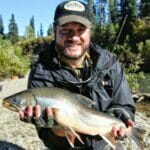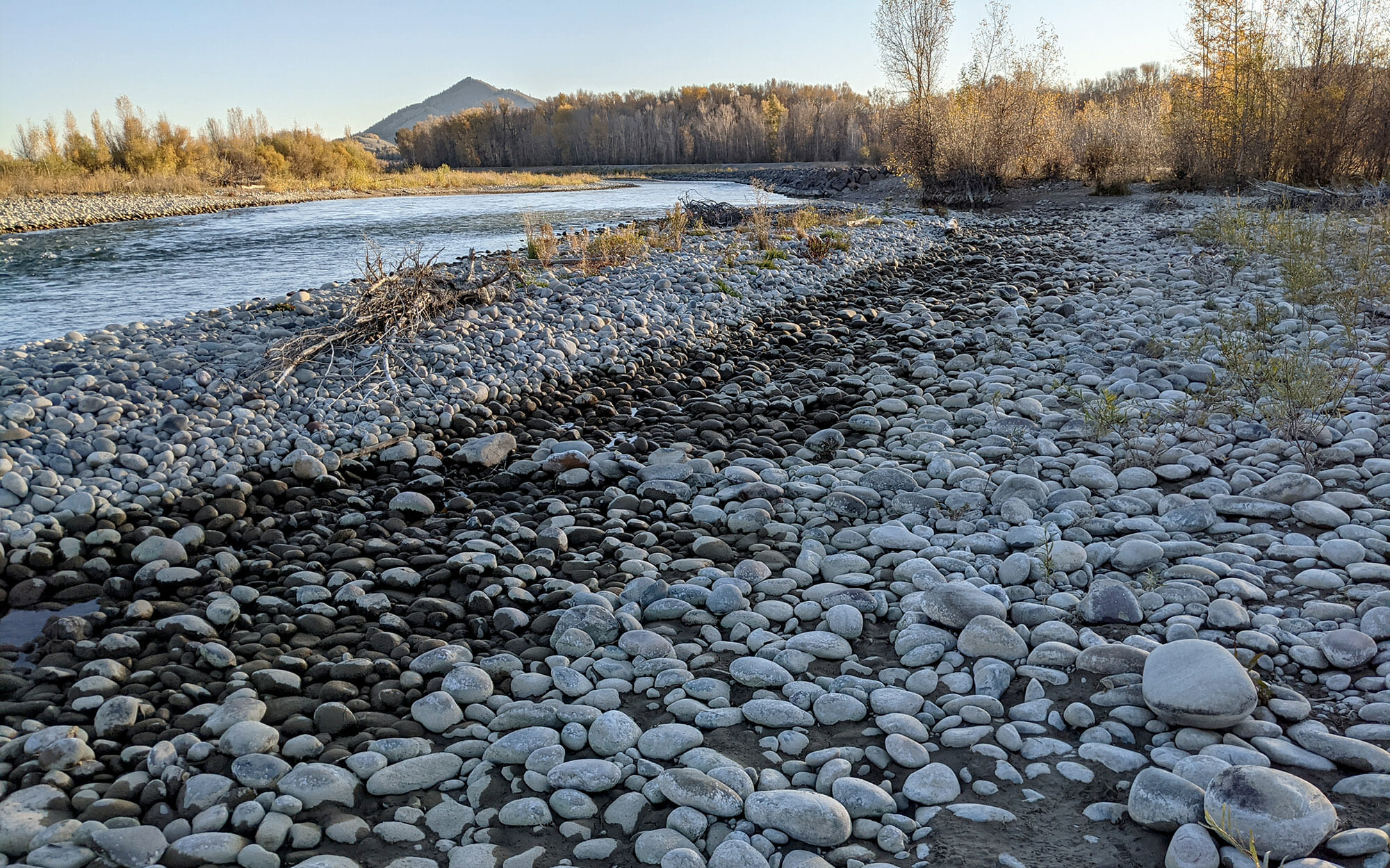When flows on the Upper Snake in Wyoming were quickly dropped, TU and the people of Jackson showed up to document the impacts—and save stranded cutthroats.
Major drops in the Snake River coming out of Jackson Lake Dam happen each year at the end of the irrigation season, but the drastically dry summer of 2021 left water managers needing to transition quickly from delivering to storing water in hopes of filling nearly-dry reservoirs for 2022.
That makes good sense for irrigators in Idaho who own most of Jackson Lake’s water rights, but the Snake runs for a long distance through Wyoming’s prime cutthroat country before it reaches diversions to farm fields. Sudden drawdowns can be hard on fish that respond better to more consistent, or at least gradual, decreases, and the proposed schedule for 2021 by the Bureau of Reclamation were set up to have an outsized impact on fish and aquatic invertebrates unable to swim out of rapidly-drained side channels.
Over the course of five and a half days, the Snake was slated to go from roughly 3,000 cubic feet of water per second to 280 – a flow reduction of 90 percent.
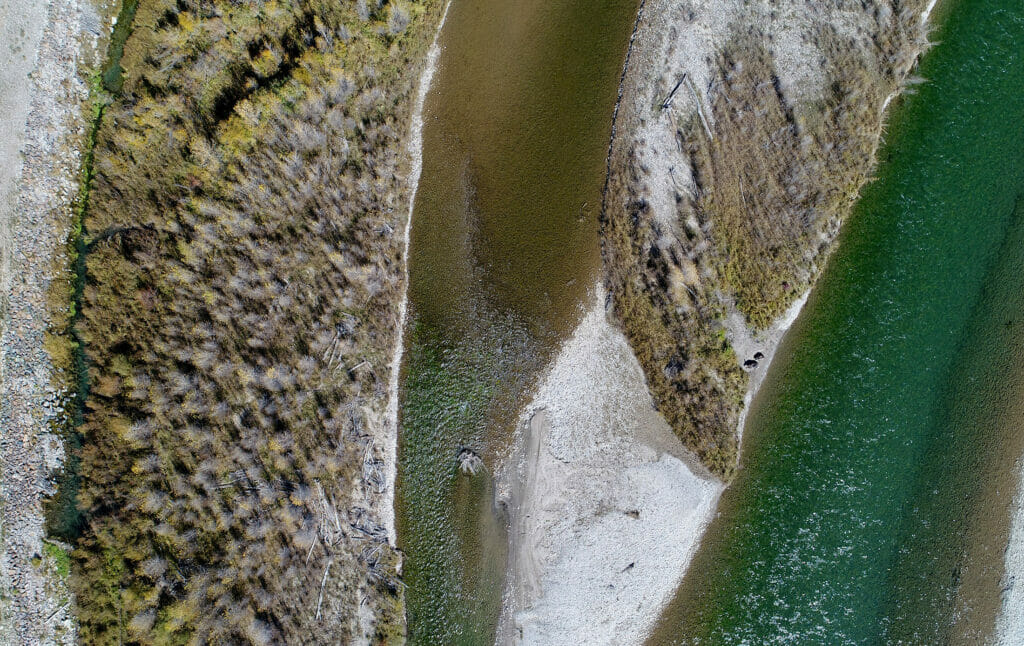
“The change from what we had been experiencing all summer was so drastic it was alarming,” said Maggie Heumann, a Jackson Hole Trout Unlimited chapter board member and former manager of the Orvis store in Jackson (now TU’s Volunteer Operations Manager). “We had been warning anglers all summer about fishing the Snake because the water was so high due to irrigation needs that wade fishing was dangerous. And then we were facing the loss of fish to get the reservoirs ready for irrigation needs next year.”
There have been drastic reductions in the Snake before, and some recognized what might be coming. Local duo Paul Bruun, an outdoor columnist at the Jackson Hole News & Guide and author of TROUT magazine’s Classics column, and Jean Williams Bruun, a fly-fishing guide for the Wyoming Angling Company, had seen the Snake drop rapidly in past drought years and began alerting agency personnel and the community starting back in June.
“They and other valley old-timers recalled when flows in the 1970s and ’80s had been dropped precipitously to extremely low levels, and the fish and macroinvertebrate stranding and loss that followed,” Leslie Steen, the Northwest Wyoming Program Director for Trout Unlimited, wrote in an opinion piece on the issue in the Jackson newspaper. “Those conditions spurred the Jackson Hole Trout Unlimited chapter and Game and Fish to go to bat for the purchase of water rights by the state of Wyoming in the 1990s to guarantee minimum winter flows for the health of the fishery. Then and now, Trout Unlimited and partners recognize the importance of conserving this uniquely intact native Snake River cutthroat trout fishery for the local ecosystem, community and economy.”
In the days before the drawdown, partners involved in a decade-long effort to restore fish passage to Spread Creek, a tributary to the Snake River, had gathered to celebrate a milestone. During the evening, the talk eventually turned to the approaching drawdown. They hatched a plan. While it was too late to change this year’s schedule – it had already been extended from four days to five and a half at the request of fisheries managers from Grand Teton National Park and the Wyoming Game and Fish Department, and the Bureau did not have any more wiggle room – TU staff and agency and nonprofit partners decided to focus on documentation of impacts. The community response that followed was impressive, to say the least.
“Jean [Bruun] really deserves a lot of the credit for getting everybody involved,” said Diana Miller, a fisheries biologist with Wyoming Game and Fish Department based out of Jackson. “She asked us what we could do so we wouldn’t end up in the same situation again. It is not easy to herd cats and she really pulled everybody together. How our community came together was really, really great. Even people not interested in fishing were asking us what they could to do help.”
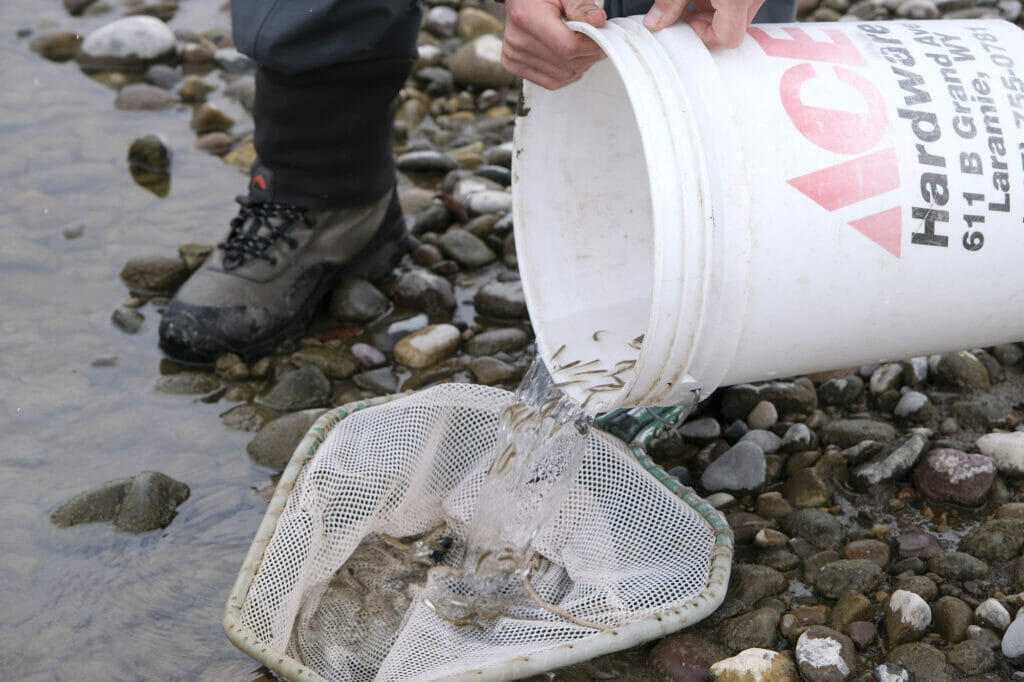
The call went out for help, and the people of Jackson showed up. From fishing guides and shop owners driving in rebar stakes and taking repeat photo points to help record how much and how fast the water dropped, to young students from the Teton Science School documenting the losses of aquatic invertebrates, to volunteers taking the day off to rescue fish in the river around the town of Wilson, they logged well over 300 work hours.
TU helped coordinate angler science and other documentation efforts by agency partners. TU Snake River Headwaters Conservation Intern Bri Agenbroad made rebar stakes with colored tape at 3 and 6 inch intervals and distributed them to the initial float team, and then compiled the location of the stakes into a Google Map that could be found by subsequent floaters. Park biologists set up time-lapse cameras to complement these efforts. Steen put out the call in the local newspaper and social media to ask angler scientists to flag locations of stranded fish in the TU RIVERS app, then got locations to Game and Fish and the Park so they could rescue as many of them as possible. Even staff from Trout Unlimited’s Science team arrived in Jackson to help.
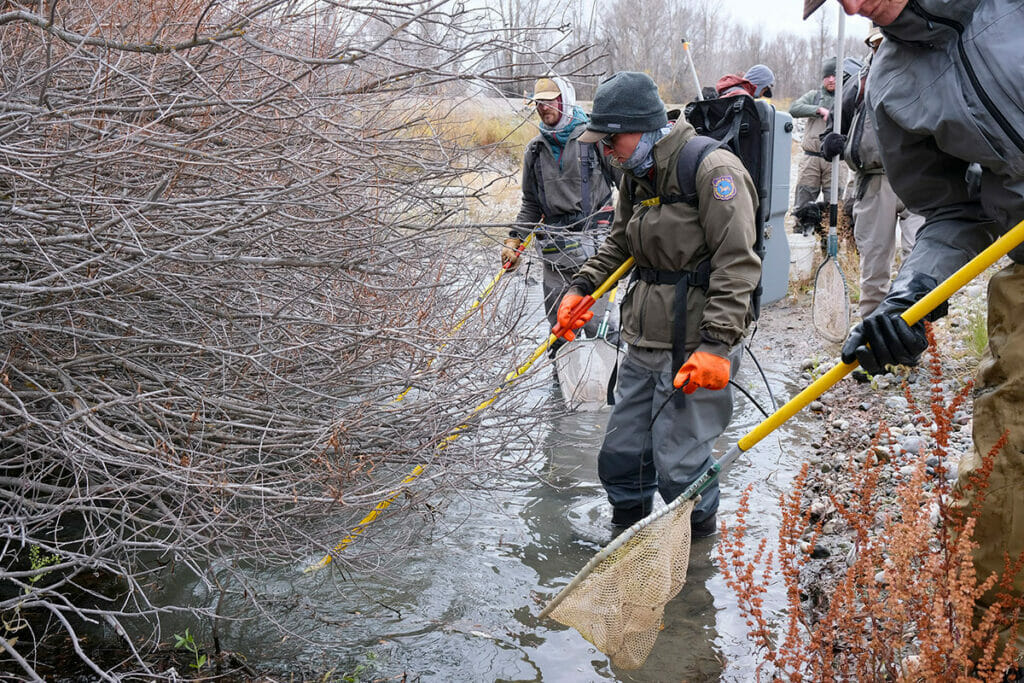
Matt Barney drove from the TU Science team office in Boise and spent the five days of the drawdown flying a drone over the river to record the changes in the river system, particularly in side channels. There were plenty of challenges in finding a section of the river Barney could document because part of the Snake is in Grand Teton National Park and because of the proximity of the river to the Jackson Hole Airport. Both restrict drone flights.
He had to settle on a 3-mile stretch of the river, but still compiled more than 6,600 still photos and video of the river over the duration of the drawdown.
“We laid out some representative reaches that we could access with the drone and programmed it to fly the same paths every time,” Barney said. “We were looking at how representative pools changed over time. With a better understanding of channel morphology and the changes that occurred we can model similar types of patterns for other stretches of the river and assume the same thing is happening in those places.”
The drone data is now being analyzed by the Teton Conservation District, who will see if there are important threshold flows at which most side channels become dewatered. This information may be able to provide insight into how flow drawdowns can be managed in the future.
It wasn’t feasible for Barney to identify areas where fish were trapped, although there were certain places where stranded fish were obvious as he walked along the river to take the drone imagery.
Answering the call for help, guides, students, and other community members volunteered to float or walk along the river looking for trapped fish, using Trout Unlimited’s RIVERS App to mark locations for Wyoming Game and Fish Department biologists and other volunteers to visit and get the fish back to the mainstem Snake.
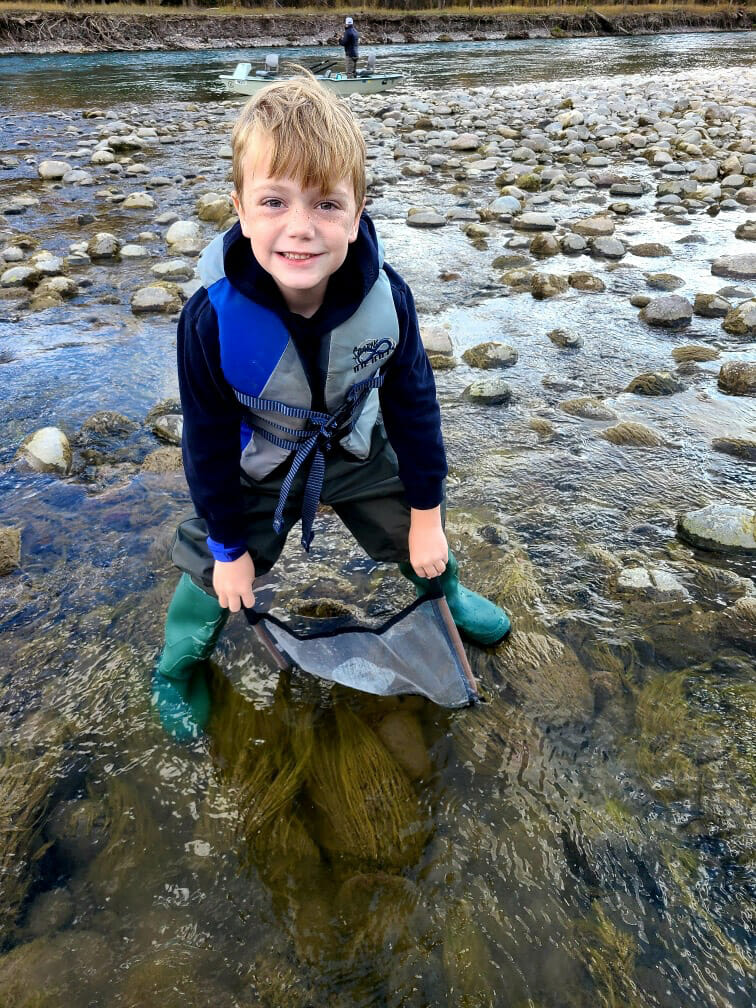
Miller said a number of Snake River cutthroat trout were rescued from pools that would eventually go dry, but the majority of those fish were young of year or juvenile trout. That means the fishery may not see an impact in the next year or two, but could see lower fish numbers for a few years. Other common native fish rescued included whitefish, sculpin and suckers. While this year’s fish rescue efforts provide only a snapshot of those that were spotted and subsequently saved, if similar drawdowns occur in the coming years due to drought conditions, it could substantially affect the Snake River fish and aquatic insect populations into the future. Still, it’s difficult to know the true extent of this year’s impact relative to a more “normal” water year – the Snake gets drawn down every year to winter flows, albeit typically more gradually.
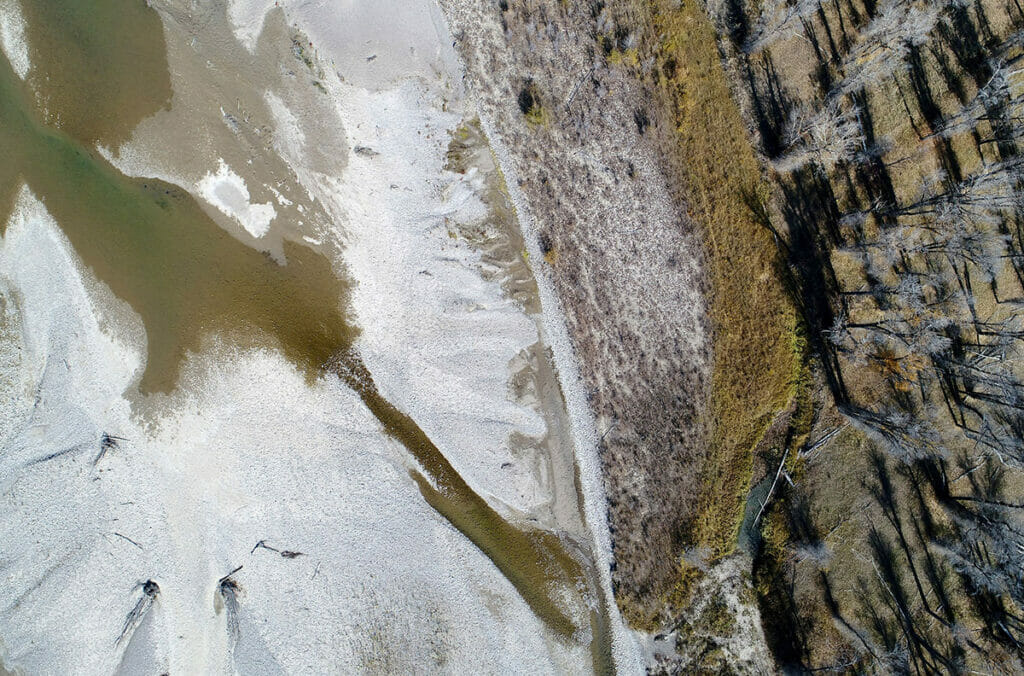
“I’m proud of how our community responded,” Jean Bruun said. “It is a privilege to live where we live, and most Jackson residents understand that and want to do what they can to keep this place so special. This is not just a fishing or environmental issue. It’s a living thing issue. We understand the importance of adhering to senior water rights downstream, but we believe that water can be provided in a responsible way that does not leave the Snake River ecosystem in distress.”
Documentation is only one part of the strategy for going to bat for more thoughtful management of flows out of Jackson Lake for the Snake River fishery. As Steen’s op-ed highlights, increased collaboration and coordination by agency partners will be key to better outcomes in the future, particularly if drought sticks around. So is filling in information gaps regarding best practices for keeping the fishery healthy, including understanding ideal rampdown rates and comparing stranding levels across years. “The silver lining is that this increased coordination is already happening,” said Steen. “The agencies are being proactive in responding to the public’s concerns, and are looking into what can be done in the future to minimize impacts to the fish and aquatic ecosystem.”
Fish rescue photos courtesy of Bob Peters.


